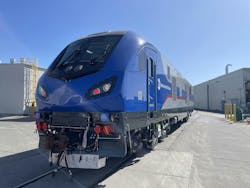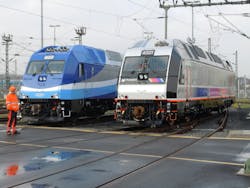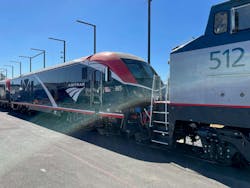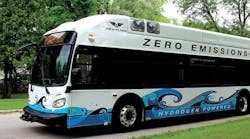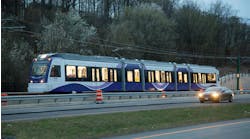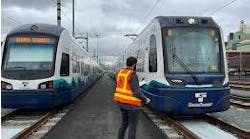How rail operators are tackling the transition to cleaner technology
Passenger rail has long been known as an energy efficient and sustainable mode of travel, especially when compared to single occupancy vehicles. However, with increasing consumer demand for eco-friendly travel, coupled with federal and state initiatives pushing the public sector towards cleaner energy technologies, the stage is set for sweeping changes in how transit agencies approach procuring and integrating lower-emission equipment and vehicles – including for passenger rail.
The transition to zero-emissions technology – whether that be battery electric or hydrogen fuel cell technology – is well documented on the bus side, with efforts underway in states like California and Illinois. Yet, significant challenges remain for passenger rail agencies to make a similar net-zero transition. For one, the feasible range of battery-electric power is still limited, especially for longer distance commuter rail services located within the heavily traveled Northeast Corridor (NEC). while concerns remain about the overall cost and availability of hydrogen.
Instead, what has risen in popularity during the past 15 years is the transition to dual-powered locomotive technology. This is especially true for legacy railroads like Amtrak, New Jersey Transit (NJ Transit) and the Metropolitan Transportation Authority’s Long Island Rail Road (LIRR) and Metro-North Railroad (Metro-North), which have already electrified core parts of their system.
The most recent example of this transition is Metro-North's introduction of the SC42-DM locomotive, which boasts an 85 percent reduction in air pollutants when compared to its predecessors. Built by Siemens Mobility with design reviews, test coverage and vehicle inspection services supported by STV, these new locomotives can travel farther under electric power than Metro-North’s current fleet. They will start to go into revenue service along the Poughkeepsie, Southeast, Danbury and Waterbury branches in 2025.
Transitioning from diesel to dual-powered locomotives
Dual-powered locomotives serve multiple purposes for the rail agencies that have procured and integrated them. In addition to replacing some of the diesel-powered locomotives with cleaner technology, they also allow rail agencies to potentially provide one-seat rides to commuters traveling between electrified and non-electrified territories. Due to concern with locomotive exhaust in tunnels, certain policies and regulations – most notably the New York City statute that bans use of combustion-powered vehicles in the Park Avenue tunnel serving Grand Central Terminal – commuters traveling from a non-electrified region on the LIRR, Metro-North or NJ Transit would need to transfer to an all-electric train set if they were traveling all the way into New York City. Since the non-electrified sections of these legacy systems tend to be the farthest away distance-wise from New York, having this additional impediment for commuters who need access to the city potentially has both environmental and economic consequences.
To that end, the SC42-DM improves upon its dual-powered predecessor, which only operated under electric power in the four miles of tunnel into and out of Grand Central Terminal. These new locomotives are expected to operate in electric mode the entire 102 miles of Metro-North's third rail territory, which extends to Croton-Harmon, Southeast and Pelham.
Reducing nitrogen oxide emissions by almost 90 percent
Similarly, in 2022, Amtrak introduced its ALC-42 locomotives on which the SC42-DM is based. Also built by Siemens, with procurement and engineering support from STV, these locomotives reduce nitrogen oxide emissions by more than 89 percent and particulate matter by 95 percent while consuming less fuel than its predecessors and hitting a top speed of 125 mph. The ongoing Amtrak Airo procurement will include dual-mode propulsion. From the passenger experience perspective, these dual-mode trains afford Amtrak the ability to reduce dwell time at stations like Washington, D.C., that have historically required passengers traveling between electrified and non-electrified territory to transfer trains or wait while the locomotive is swapped.
North America’s first transcontinental locomotive procurement
Further demonstrating the popularity of dual-powered locomotive technology, about a decade ago, STV was providing design, inspection, testing and other engineering support services for the procurement of the ALP-45DP locomotive for NJ Transit – the agency’s first foray into dual-powered technology. In the middle of this program, the STV team was approached by another agency – Agence Métropolitaine de Transport (now Exo) in Montreal, Quebec, – about the need for a similar locomotive for its commuter rail service. Rather than go through the lengthy (and costly) process of designing and procuring an entirely separate locomotive, the team coordinated an order with car builder Bombardier, and both NJ Transit and Exo marked the first ever transcontinental locomotive procurement between two major North American transit agencies.
Looking forward, the agencies that have already developed a first-generation dual-powered locomotive – like LIRR and Metro-North – are replacing those vehicles with cleaner, more energy efficient locomotives. Meanwhile, other agencies, especially those within the NEC, have also expressed a high level of interest in developing their own dual-powered locomotives The reasoning behind this transition is clear: Cleaner energy rail solutions not only address climate change, but also enhance energy security, reduce urban pollution and foster economic growth in communities connected by rail.

John Batey | Vice President of Vehicle Engineering at STV
John Batey, PE, is vice president of vehicle engineering at STV, where he works in railroad-related project management, design engineering oversight and maintenance planning of transit vehicles. With more than 20 years of experience, Batey manages large vehicle procurement programs, as well as dynamic vehicle clearance analyses, safety and hazard analyses and fare collection system technologies. He has played a key role in transit programs such as the Amtrak Charger locomotive procurement and the Massachusetts Bay Transportation Authority Orange and Red Line vehicle procurement.

